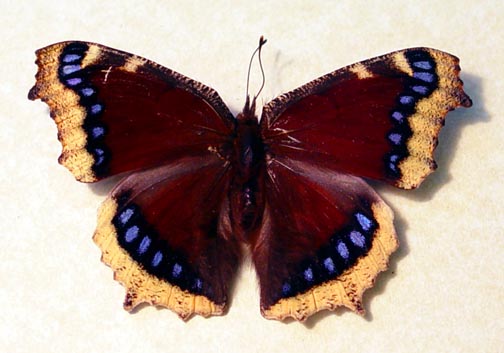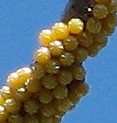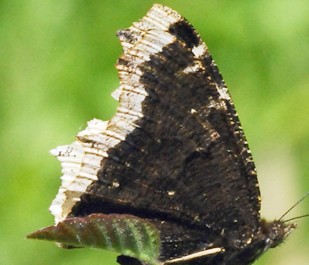 Morning cloaks can be found in almost all of the Northern Hemisphere south to northern South America . Exceptions are the high Arctic, and sub tropical and desert regions. They live in a wide variety of environments but especially favor moist deciduous forests where they live in forest edges, gardens, parks, open woodlands, water courses, and groves. With a wing span of up to four inches, morning cloaks are among the largest butterflies and with unique coloration they are easily recognized. On the dorsal side the wings are dark brownish maroon, iridescent, and have a ragged creamy yellow border highlighted by bright blue spots on the inward side. The ventral sides of the wings have gray striations and the same creamy yellow borders, providing camouflage when the butterfly is on the bark of a tree.
Morning cloaks can be found in almost all of the Northern Hemisphere south to northern South America . Exceptions are the high Arctic, and sub tropical and desert regions. They live in a wide variety of environments but especially favor moist deciduous forests where they live in forest edges, gardens, parks, open woodlands, water courses, and groves. With a wing span of up to four inches, morning cloaks are among the largest butterflies and with unique coloration they are easily recognized. On the dorsal side the wings are dark brownish maroon, iridescent, and have a ragged creamy yellow border highlighted by bright blue spots on the inward side. The ventral sides of the wings have gray striations and the same creamy yellow borders, providing camouflage when the butterfly is on the bark of a tree.
 Male morning cloaks exhibit lekking behavior meaning they settle and defend a territory that will attract the maximum number of females for mating. They usually perch on a high spot in the sun. In spring males mate with multiple females. Once mated the females lay their eggs in large clusters around the twigs of host plants. The eggs are a first pale yellow but become red and then black as they mature. The caterpillars are up to two inches long, velvety black with white speckles and a row
Male morning cloaks exhibit lekking behavior meaning they settle and defend a territory that will attract the maximum number of females for mating. They usually perch on a high spot in the sun. In spring males mate with multiple females. Once mated the females lay their eggs in large clusters around the twigs of host plants. The eggs are a first pale yellow but become red and then black as they mature. The caterpillars are up to two inches long, velvety black with white speckles and a row  of red spots, and have several rows of black branched bristles. They stay together and feed, then pupate forming a tan to gray chrysalis with two head horns, a beak, and several red tipped spikes. Adults emerge about fifteen days later in June or July, briefly feed, and aestivate until fall when they feed again and then overwinter in tree cavities or under loose tree bark. Only a few migrate. When spring arrives mating begins again.
of red spots, and have several rows of black branched bristles. They stay together and feed, then pupate forming a tan to gray chrysalis with two head horns, a beak, and several red tipped spikes. Adults emerge about fifteen days later in June or July, briefly feed, and aestivate until fall when they feed again and then overwinter in tree cavities or under loose tree bark. Only a few migrate. When spring arrives mating begins again.
 Morning cloaks are unique in several ways. In addition to their large size, unusual appearance, and overwintering habit, they are one of the longest lived butterflies, with a single adult living up to a year. Few butterflies have such a great contrast between the appearance of the dorsal and ventral side of their wings; the camouflage dorsal side protects them well from predators when they rest on tree trunks. If a predator does approaches, however, they fly away quickly while emitting “click” sounds.
Morning cloaks are unique in several ways. In addition to their large size, unusual appearance, and overwintering habit, they are one of the longest lived butterflies, with a single adult living up to a year. Few butterflies have such a great contrast between the appearance of the dorsal and ventral side of their wings; the camouflage dorsal side protects them well from predators when they rest on tree trunks. If a predator does approaches, however, they fly away quickly while emitting “click” sounds.
The caterpillars eat deciduous broadleaf trees and especially like willow (Salix), American elm (Ulmus americana), hackberry (Celtis occidentalis), cottonwood (Populus) and paper birch (Betula papyrifera), as well as wild rose. The adults rarely go after flower nectar preferring rotting fruit and tree sap, especially that of oak.